MATHEMATICS
(Maximum Marks: 100)
(Time Allowed: Three Hours)
(Candidates are allowed additional 15 minutes for only reading the paper.
They must NOT start writing during this time)
The Question Paper consists of three sections A, B and C.
Candidates are required to attempt all questions from Section A and all question EITHER from Section B OR Section C
Section A: Internal choice has been provided in three questions of four marks each and two questions of six marks each.
Section B: Internal choice has been provided in two question of four marks each.
Section C: Internal choice has been provided in two question of four marks each.
All working, including rough work, should be done on the same sheet as, and adjacent to, the rest of the answer.
The intended marks for questions or parts of questions are given in brackets [ ].
Mathematical tables and graphs papers are provided.
SECTION – A (80 Marks)
Question 1: [10 × 2]
(i) The binary operation is defined as
(iii) Solve :
(iv) Without expanding at any stage, find the value of:
(v) Find the value of constant so that the function
defined as:
(vi) Find the approximate change in the volume of a cube of side
meters caused by decreasing the side by
.
(viii) Find the differential equation of the family of concentric circles
(x) In a race, the probabilities of A and B winning the race are respectively. Find the probability of neither of them winning the race.
Answer:
(i)
We can compare corresponding terms. We get
(iii)
(v)
(vi) Volume of a cube
Hence change in volume
Hence change in volume decrease by
(viii) Family of concentric circles is
Therefore Differential w.r.t.
(x) win the race be
win the race be
Question 2: If the function is invertible then find its inverse. Hence prove that
Answer:
Squaring both sides
Question 3: , prove that
Answer:
Question 4: Use properties of determinants to solve for :
Answer:
But
Question 5: [4]
OR
(b) Verify Rolle’s theorem for the following function:
Answer:
(a) Continuity at
is continuous at
Now differentiate at
Hence is not differentiable at
(b)
(i) is continuous on
because
are continuous function on its domain.
(ii) is differentiable on
(iii)
(iv) be number such that
Therefore Rolle’s theorem verified
Answer:
differentiating both sides w.r.t.
Again differentiating both sides w.r.t.
Answer:
Put
Question 8: [4]
(a) Find the points on the curve at which the equation of the tangent is parallel to the x-axis.
OR
(b) Water is dripping out from a conical funnel of semi-vertical angle at the uniform rate of
in the surface, through a tiny hole at the vertex of the bottom. When the slant height of the water level is 4 cm, find the rate of decrease of the slant height of the water.
Answer:
(a) … … … … … (i)
, then
(b) be the radius,
be the height and
be the volume of the funnel at any time
.
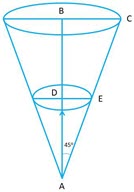
… … … … … (i)
be the slant height of the funnel
Given : Semi-vertical angle in the
:
… … … … … (ii)
therefore the equation (i) can be rewritten as:
Differentiate w.r.t. :
Since it is given that rate of change (decrease) of volume of water w.r.t. is
Therefore
Question 9: [4]
OR
(b) The population of a town grows at the rate of per year. Using differential equation, find how long will it take for the population to grow
times.
Answer:
Therefore solution of the linear differential equation
(Since increase in population speeds up with increase in population) and be the population at anytime
.
integrating both sides
where
Here is the rate of increase and
is the initial population
then
Given to find the time taken to attain
times population, so
Taking log on both sides
Question 10: [6]
(a) Using matrices, solve the following system of equations :
OR
(b) Using elementary transformation, find the inverse of the matrix :
Answer:
(a) Given, the three equations:
We can write this in the form of , i.e. as follows:
Hence it is a non – singular matrix. Therefore $latex A^{-1} exists. Let us find the (adj A) by finding the minors and co-factors
, then
Matrix multiplication can be done by multiplying the rows of matrix with the column of matrix
.
Hence ,
exists.
Question 11: speaks truth in
of the cases, while
is
of the cases. In what percent of cases are they likely to contradict each other in stating the same fact ? [4]
Answer:
They contradict each other
of cases they likely to contradict each other
Question 12: A cone is inscribed in a sphere of radius . If the volume of the cone is maximum, find its height. [6]
Answer:
be a cone of greatest volume inscribed in a sphere of radius
. It is obvious that for maximum volume the axis of the cone must be along a diameter of the sphere.
be the axis of the cone and
be the center of the sphere such that
.
Then, height of cone. Applying Pythagoras theorem,
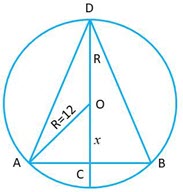
be the volume of the cone, then
… … … … … (i)
Thus, is maximum when
. Putting
in (i), we obtain
Height of the cone
Question 13: [6]
OR
Answer:
… … … … … (i)
Therefore
… … … … … (ii)
Adding equation (i) and (ii)
Put
When
When
Question 14: From a lot of items containing
defective items, a sample of
items are drawn at random. Let the random variable
denote the number of defective items in the sample. If the sample is drawn without replacement, find :
(a) The probability distribution of
(b) Mean of
(c) Variance of [6]
Answer:
In items
defective and
non-defective.
is the probability of defective items
number of defective items.
SECTION B (20 Marks)
Question 15: [3 × 2]
(a) Find if the scalar projection of
is
units.
(b) The Cartesian equation of line is : . Find the vector equation of a line passing through
and parallel to the given line.
(c) Find the equation of the plane through the intersection of the planes and passing through the origin.
Answer:
Therefore
(b) Cartesian equation of a line is
i.e.
Dividing by throughout we get
Therefore D.r.s of the above line is . Now, equation of a line passing through point
and parallel to the above line whose d.r.s. is
is
(c) Equation of 1st plane is:
i.e.
… … … … … (i)
Equation of 2nd plane is:
i.e.
… … … … … (ii)
Now, equation of a plane passing through intersection of given planes is:
Since plane is passing through the origin
Question 16: [4]
OR
(b) Show that the four points A,B, C and D with position vectors
Answer:

Therefore
(b) Given:
Therefore Points are coplanar
Question 17: [4]
(a) Draw a rough sketch of the curve and find the area of the region bounded by curve and the line
.
OR
(b) Sketch the graph of . Using integration, find the area of the region bounded by the curve
.
Answer:
(a) Given equation is 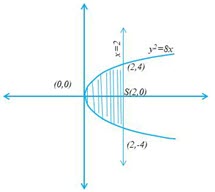
Comparing with
We get
Also, meets
are their point of intersection.
Required are
sq. units.
(b) ,
,
Therefore the required area: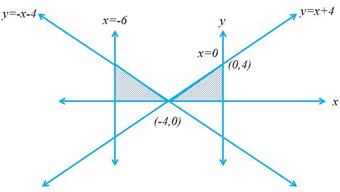
sq. units
Question 18: Find the image of a point having position vector : in the plane
[6]
Answer:
be root of point
in the plane
can of
is
substitute in plane
Therefore by mid point formula
SECTION C (20 Marks)
Question 19: [3 × 2]
(a) Given the total cost function of units of a commodity as
Find: (i) Marginal cost function (ii) Average cost function
(b) Find the coefficient of correlation from the regression lines: .
(c) The average cost function associated with producing and marketing units of an item is given by
. Find the range of values of the output
, from which
is increasing.
Answer:
Marginal cost function
Average cost function
(b) be of
on
.
be of
on
Therefore for will keep increasing.
Question 20: [4]
(a) Find the line of regression of on
from the following table.
$latex \displaystyle \left| \begin{array}{c | c | c | c | c | c }
\hline \text{ For } x \hspace{1.0cm} & 1 \hspace{1.0cm} & 2 \hspace{1.0cm} & 3 \hspace{1.0cm} & 4 \hspace{1.0cm} & \hspace{1.0cm} 5 \hspace{1.0cm} \\
\hline \text{ For } y \hspace{1.0cm} & 7 \hspace{1.0cm} & 6 \hspace{1.0cm} & 5 \hspace{1.0cm} & 4 \hspace{1.0cm} & \hspace{1.0cm} 3 \hspace{1.0cm} \\
\hline \end{array} \right| $
Hence estimate the value of when
OR
(b) From the given data:
$latex \displaystyle \left| \begin{array}{c | c | c }
\hline \text{ Variable } \hspace{1.0cm} & x \hspace{1.0cm} & y \hspace{1.0cm} \\
\hline \text{ Mean } \hspace{1.0cm} & 6 \hspace{1.0cm} & 8 \hspace{1.0cm} \\
\hline \text{ Standard Deviation } \hspace{1.0cm} & 4 \hspace{1.0cm} & 6 \hspace{1.0cm} \\
\hline \end{array} \right| $
(i) Regression coefficients
(ii) Regression line on
(iii) Most likely value of when
Answer:
(a) $latex \displaystyle \left| \begin{array}{c | c | c | c | c | c | c }
\hline x \hspace{1.0cm} & y \hspace{1.0cm} & x-1 \hspace{1.0cm} & y-5 \hspace{1.0cm} & dx.dy \hspace{1.0cm} & (dx)^2 \hspace{1.0cm} & (dy)^2 \hspace{1.0cm} \\
\hline 1 \hspace{1.0cm} & 7 \hspace{1.0cm} & 0 \hspace{1.0cm} & 2 \hspace{1.0cm} & 0 \hspace{1.0cm} & 0 \hspace{1.0cm} & 4 \hspace{1.0cm} \\
\hline 2 \hspace{1.0cm} & 6 \hspace{1.0cm} & 1 \hspace{1.0cm} & 1 \hspace{1.0cm} & 1 \hspace{1.0cm} & 1 \hspace{1.0cm} & 1 \hspace{1.0cm} \\
\hline 3 \hspace{1.0cm} & 5 \hspace{1.0cm} & 2 \hspace{1.0cm} & 0 \hspace{1.0cm} & 0 \hspace{1.0cm} & 4 \hspace{1.0cm} & 4 \hspace{1.0cm} \\
\hline 4 \hspace{1.0cm} & 4 \hspace{1.0cm} & 3 \hspace{1.0cm} & -1 \hspace{1.0cm} & -3 \hspace{1.0cm} & 9 \hspace{1.0cm} & 1 \hspace{1.0cm} \\
\hline 5 \hspace{1.0cm} & 3 \hspace{1.0cm} & 4 \hspace{1.0cm} & -2 \hspace{1.0cm} & -8 \hspace{1.0cm} & 16 \hspace{1.0cm} & 4 \hspace{1.0cm} \\
\hline \Sigma x = 15 \hspace{1.0cm} & \Sigma y = 25 \hspace{1.0cm} & \Sigma dx = 10 \hspace{1.0cm} & \Sigma dy = 0 \hspace{1.0cm} & \Sigma dx.dy = -10 \hspace{1.0cm} & \Sigma(dx)^2 = 30 \hspace{1.0cm} & \Sigma (dy)^2 = 10 \hspace{1.0cm} \\
\hline \end{array} \right| &s=1$
Hence there is high negative correlation between .
(b) Given data is :
$latex \displaystyle \left| \begin{array}{c | c | c }
\hline \text{ Variable } \hspace{1.0cm} & x \hspace{1.0cm} & y \hspace{1.0cm} \\
\hline \text{ Mean } \hspace{1.0cm} & 6 \hspace{1.0cm} & 8 \hspace{1.0cm} \\
\hline \text{ Standard Deviation } \hspace{1.0cm} & 4 \hspace{1.0cm} & 6 \hspace{1.0cm} \\
\hline \end{array} \right| $
Question 21: [4]
(a) A product can be manufactured at a total cost , where
is the number of units produced. The price at which each unit can be sold is given by
. Determine the production level
at which the profit is maximum.What is the price per unit and profit at the level of production.
OR
(b) A manufacturer’s marginal cost function is . Find the cost involved to increase production from
units to
units.
Answer:
units are produced, then
units.
The cost involved to increase production from units to
units:
Question 22: A manufacturing company produces two type of teaching aids of Mathematics for Class X. Each type of
requires
hours for fabricating and
hour for finishing. Each type of
requires
hours for fabricating and
hours for finishing. For fabricating and finishing, the maximum labor hours available for a week are
respectively. The company makes a profit of
on each piece of type
on each piece of type
. How many pieces of type
and type
should be manufactured per week to get a maximum profit? Formulate this as a linear programming problem and solve it. Identify the feasible region from the rough sketch. [6]
Answer:
Let quantity of teaching aid and Quantity of teaching aid
Each type of requires
hours for fabricating and
hour for finishing.
… … … … … (i)
Each type of requires
hours for fabricating and
hours for finishing.
… … … … … (ii)
We know the company makes a profit of on each piece of type
on each piece of type
.
Therefore Profit … … … … … (iii)
We need to maximize . We will solve it graphically.
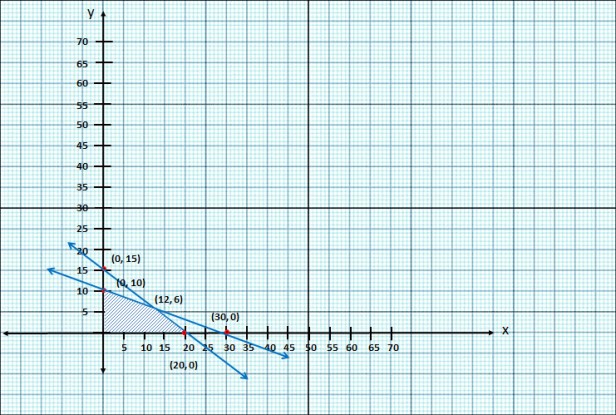
We see that the coordinates of the vertices of the feasible region are . Now calculate Profit for each of the three coordinates:
For
For
For
Therefore, the quantity of teaching aid and Quantity of teaching aid

Solution of Q.no. 19(b) is wrong, because r² <= 1 (always) and yours is greater.
i will check… thanks